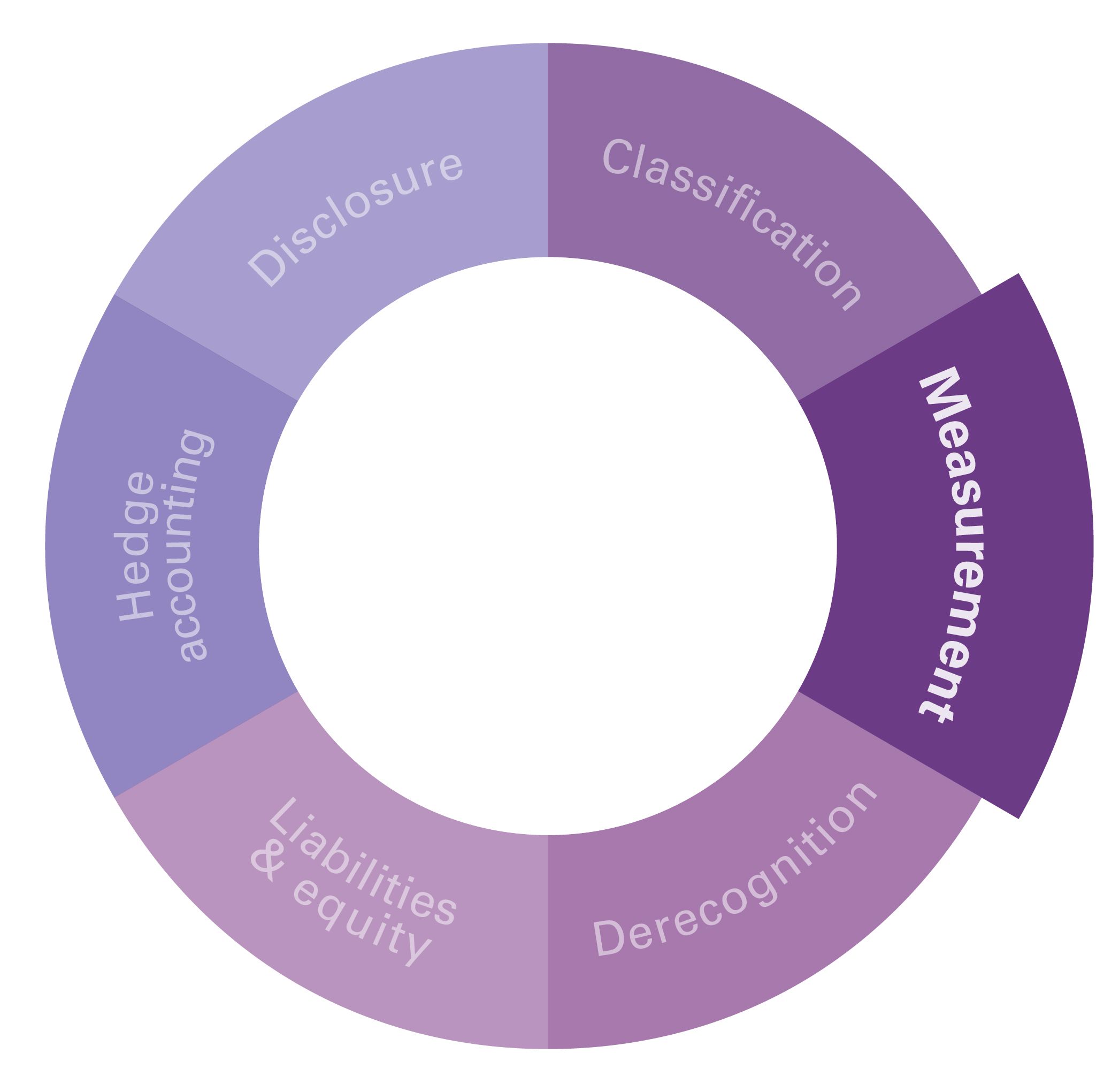AASB 9 FINANCIAL INSTRUMENTS Q&A SERIES
The accounting principles relating to loan modifications are the same for both fixed rate loans and floating rate loans. Borrowers may enter negotiations with their lender to modify the fixed margin component of floating rate loans. In this article KPMG explains how the accounting requirements are applied by borrowers to these types of modifications.

Scenario
Company B has a 5-year loan from a bank with the following key terms:
- 4 years until maturity
- principal of $10 million due on maturity
- interest payable quarterly based on 3-month BBSW plus a margin of 5%
- Company B can prepay the loan at any time without significant penalty
- on initial recognition Company B incurred $100,000 of transaction costs which it included in the carrying amount of the loan
- the original effective interest rate is BBSW + 5.23%, which comprises the contractual rate (BBSW + 5%) plus an adjustment of 0.23% to amortise the transaction costs over the life of the loan.
Company B renegotiates the terms and the bank agrees to reduce the margin to the current market rate of 4% p.a.
Company B incurs the following costs when modifying the loan:
- modification fee charged by the bank of $15,000
- bank legal fees paid directly to the bank’s lawyer of $12,000
- fees payable to an external advisor assisting B with the loan renegotiation of $18,000.
MODIFICATION ASSESSMENT
QUESTION 1
Given the loan is a floating rate loan, is Company B required to assess whether the modification to the loan is substantial or non-substantial?
Interpretive response
Yes, Company B must assess whether the modification is substantial. An assessment is required whenever the terms of a loan are modified, including where changes are made to the fixed margin of a floating rate loan.
No assessment is required for changes in the interest rate due to periodic movements in the floating benchmark rate as these changes are not modifications.
QUANTITATIVE '10% TEST'
QUESTION 2A
When performing the quantitative ’10% test’, what interest rate should Company B use to assess whether the present value of the new cash flows is more than 10% different to the carrying amount of the original loan?
Interpretive response
BBSW + 5.23% as this is the original effective interest rate.
Read Loan modifications and derecognition for further guidance.
QUESTION 2B
Which new costs and fees are included in the quantitative test?
Interpretive response
In this scenario, only the modification fee charged by the bank of $15,000 and the $12,000 of legal fees paid to the bank’s lawyer should be considered for the purposes of the 10% test. This is because only these amounts are paid by Company B to, or on behalf of, the bank.
Read New costs and fees – impact on loan modification accounting for further guidance.
NON-SUBSTANTIAL MODIFICATION
QUESTION 3A
If the modification is non-substantial, what is the discount rate Company B uses for recalculating the carrying amount?
Interpretive response
The principles in our article ’Modifications and the effective interest rate’ apply.
As the loan can be prepaid without significant penalty and the loan renegotiation was on an arm’s length basis, Company B has a choice to either:
- discount the new cash flows using the original effective interest rate of BBSW + 5.23%, in which case there is a modification gain
- discount the new cash flows using a revised effective interest rate of BBSW + 4.23%. The new contractual rate of BBSW + 4% is adjusted by 0.23% to amortise the original unamortised transaction costs over the remaining life of the loan. Under this policy there is no modification gain or loss.
Read Unamortised transaction costs and loan modifications for further guidance on accounting for original unamortised transaction costs.
QUESTION 3B
If the modification is non-substantial, how are the new transaction costs accounted for?
Interpretive response
Generally, the transaction costs incurred as part of the modification (comprising the bank fees of $15,000, the fees paid to the bank’s lawyer of $12,000 and fees paid to Company B’s advisor of $18,000) are capitalised into the new carrying amount of the loan.
However, if Company B chooses to revise the discount rate as described above in Question 3A, it can elect to expense all the new costs incurred.
Read Accounting for loan renegotiations costs for further guidance.
QUESTION 3C
How is the effective interest rate impacted if the new transaction costs are capitalised?
Interpretive response
An adjustment to the margin component of the effective interest rate is required to ensure that the capitalised transaction costs are amortised over the remaining life of the loan.
Read Accounting for loan renegotiations costs for further guidance.
SUBSTANTIAL MODIFICATION
QUESTION 4
If the modification is substantial, what is the accounting impact?
Interpretive response
The renegotiation is accounted for as an extinguishment of the old loan and the recognition of a new loan at fair value.
All remaining unamortised transaction costs should be recognised in profit or loss as part of the gain or loss on derecognition of the original loan.
Read Unamortised costs – impact on loan modifications for further guidance.
All new costs incurred are expensed immediately in profit or loss, unless it can be demonstrated that they relate solely to the recognition of the new loan, for example, taxes or registration fees payable on execution of the new liability.
Read Accounting for loan renegotiations costs for further guidance.
Getting technical
In accordance with AASB 9, when a debt instrument is restructured or refinanced and the terms have been substantially modified, the transaction is accounted for as an extinguishment of the old debt instrument, and the recognition of a new instrument at fair value. [AASB 9.3.3.2]
If an exchange of debt instruments or modification of terms is accounted for as an extinguishment, any costs or fees incurred are recognised as part of the gain or loss on the extinguishment. In our view, no transaction costs should be included in the initial measurement of the new liability unless it can be incontrovertibly demonstrated that they relate solely to the new liability and in no way relate to the modification of the old liability. This is not usually possible but may apply to taxes and registration fees payable on execution of the new liability [AASB 9.B3.3.6].
If the exchange or modification is not accounted for as an extinguishment (i.e. because the modification is non-substantial), then the amortised cost of the liability is recalculated by discounting the revised estimated future cash flows at the instrument’s original effective interest rate or, when applicable, the revised effective interest rate. [AASB 9.5.4.3]
The original contractual terms may facilitate a repricing of an otherwise fixed interest rate (or an otherwise fixed component of an interest rate) to reflect a change in periodic market rates of interest, either because the lender has a right to demand immediate repayment without significant penalty, or because the borrower has an option to prepay without significant penalty (combined with its ability to obtain alternative financing at market rates from other possible lenders).
In these cases, it appears that the entity may choose an accounting policy, to be applied consistently, to revise the original effective interest rate based on the new terms, to reflect changes in cash flows that reflect periodic changes in market rates. The revised effective interest rate would then be used to discount the modified contractual cash flows for calculation of the modification gain or loss and for subsequent calculation of amortised cost. [Insights to IFRS, Chapter 7]
In applying this policy, such a change can be seen either as a modification of contractual terms (because the contractual terms have been changed), or as a re-estimation of cash flows in accordance with the original terms of the contract). [AASB 9.B5.4.5]
If the change is seen as a modification, then any costs or fees incurred adjust the carrying amount of the liability and are amortised over the remaining term of the modified liability. [AASB 9.B3.3.6A*]
If the change is seen as a revision of cash flows, any costs or fees incurred are recognised in profit or loss immediately. This is because they do not meet the definition of transaction costs and there is no basis to include them in the measurement of the existing financial instrument.
At the time of modification, the carrying amount of a financial liability may include an unamortised portion of costs that were included in the initial measurement of the liability. If an entity applies the accounting policy to account for a revision of the interest rate (or a component of the interest rate) of a financial liability using the guidance on floating rate financial instruments, then it appears that it should account for these unamortised original transaction costs by continuing to amortise them over the remaining term of the liability by using a post-revision effective interest rate that includes the effect of those transaction costs. This is because the liability continues to be recognised and transaction costs are amortised over the expected life of a financial instrument. [AASB 9.A, B5.4.4]
If an entity does not apply the accounting policy to apply the guidance on floating rate financial instruments, then it does not adjust the original effective interest rate in calculating the gain or loss on revision – i.e. the rate continues to include the effects of any costs that were included in the initial measurement of the asset. [AASB 9.5.4.3, B5.4.6]
Footnote
*As amended by AASB 2020-3 Amendments to Australian Accounting Standards – Annual Improvements 2018-2020 and Other Amendments, which is effective for annual reporting periods beginning on or after 1 January 2022 with early application permitted.
Find out more
- How does a borrower account for a waiver of loan repayments?
- How does a borrower account for loan repayment holidays obtained during the COVID-19 pandemic?
- When do loan modifications result in derecognition?
- How does a borrower account for a modification to a prepayable fixed rate loan?
- How do new costs and fees impact modification accounting?
- Does the effective interest rate change with non-substantial loan modifications?
- How does a borrower account for loan renegotiation costs?
- How are unamortised transaction costs accounted for on loan modification?



